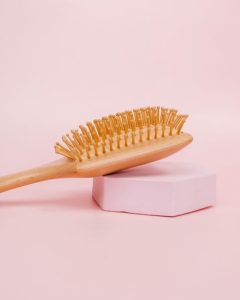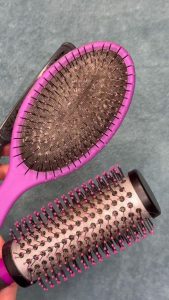Combs are essential tools for maintaining healthy, groomed hair. But over time, they can accumulate hair, dust, and product buildup. Regular cleaning is crucial for removing these unwanted elements and keeping your comb hygienic. Here’s a comprehensive guide on how to effectively clean your combs at home, using readily available supplies.
Understanding Why Cleaning Your Comb Matters
Regularly cleaning your comb offers several benefits:
Hygiene:
Removes hair, dust, and product buildup, which can harbor bacteria and contribute to scalp irritation.
Performance:
A clean comb glides through hair more smoothly, reducing tangles and promoting even product distribution.
Lifespan:
Proper cleaning prevents dirt and debris from accumulating and damaging the comb’s materials.

Gathering Cleaning Supplies
The cleaning method you choose depends on the type of comb you have. Here are some general supplies you might need:
- Warm water
- Mild shampoo or dish soap
- Baking soda (optional)
- White vinegar (optional)
- Soft-bristled toothbrush
- Clean towel
Important: Avoid harsh chemicals or abrasive cleaners, as they can damage your comb.
Cleaning Different Types of Combs
Here’s a breakdown of cleaning methods for common comb types:
-
Fine-tooth combs: Fill a bowl with warm water and add a few drops of mild shampoo or dish soap. Gently dip and swish the comb to loosen debris. Use a soft-bristled toothbrush to clean between the teeth. Rinse thoroughly with clean water and pat dry with a towel.
-
Wide-tooth combs: Similar to fine-tooth combs, use warm water, shampoo/dish soap, and a soft brush. You can also soak the comb for 15-30 minutes before rinsing and drying.
-
Wooden combs: For wooden combs, avoid soaking. Instead, use a damp cloth with a mild soap solution to wipe down the comb. Rinse the cloth and wipe the comb with clean water to remove soap residue. Dry thoroughly with a towel.
-
Metal combs: Metal combs can be cleaned similarly to fine-tooth combs. However, ensure the water isn’t too hot, as it might damage the metal.

For stubborn product buildup: Make a paste with baking soda and a few drops of water. Apply the paste to the comb and let it sit for 15 minutes. Use the soft-bristled brush to scrub gently, then rinse thoroughly and dry.
For deep cleaning (optional): Soak your comb in a solution of equal parts white vinegar and water for 30 minutes. This can help remove mineral deposits and heavy buildup. However, avoid using vinegar on wooden combs. Rinse thoroughly and dry completely.
Drying Your Comb Properly
- After cleaning, it’s essential to dry your comb completely to prevent mold or mildew growth.
- Gently pat the comb with a clean towel to remove excess moisture.
- Let the comb air dry completely in a well-ventilated area out of direct sunlight.
Maintaining Comb Hygiene (Brushing Habits)
- Regularly remove hair from your comb after each use.
- Avoid sharing your comb with others to prevent the spread of germs.
- Clean your comb at least once a week, or more frequently if you use a lot of styling products.
By following these simple cleaning and maintenance tips, you can keep your combs clean, hygienic, and functioning optimally for longer.

Keeping Your Combs Fresh (Additional Tips)
Here are some additional tips to keep your combs clean and fresh for longer:
-
Consider a comb cleaning brush: These small brushes are specifically designed to remove hair and debris from combs, especially between fine teeth.
-
Minimize product buildup: Apply styling products directly to your hair whenever possible, rather than coating the comb itself. This helps reduce product buildup on the comb.
-
Replace worn-out combs: Over time, combs can become bent, cracked, or dull. If your comb shows signs of wear and tear, consider replacing it to ensure optimal performance and hygiene.
-
Be gentle: Combs are tools, but they can be delicate. Avoid using harsh scrubbing or abrasive materials, as this can damage the comb’s bristles or body.
-
Air it out: When not in use, allow your comb to air dry in a well-ventilated area. This helps prevent moisture buildup and discourages mold growth.
-
Store it neatly: Avoid storing your comb in damp bathrooms or cluttered drawers. Instead, keep it in a clean, dry location with good air circulation. A dedicated comb holder on your vanity or a separate comb compartment in your bathroom drawer can be helpful.
By following these cleaning and maintenance tips, you can extend the lifespan of your combs and keep them functioning effectively for longer. This contributes to a healthy hair care routine!
Regularly cleaning your combs is an essential part of maintaining good hair hygiene. By following the steps outlined in this guide, you can keep your combs clean, free of debris, and functioning at their best. Remember, a clean comb promotes healthy hair and a smooth, snag-free grooming experience.

Why Cleaning Your Comb Matters
Regular comb cleaning offers several benefits:
- Hygiene: Removes hair, dust, and product buildup, which can harbor bacteria and contribute to scalp irritation.
- Performance: A clean comb glides through hair more smoothly, reducing tangles and promoting even product distribution.
- Lifespan: Proper cleaning prevents dirt and debris from accumulating and damaging the comb’s materials.
Step-by-Step Guide to Cleaning Your Comb
- Preparation: Gather necessary materials (e.g., mild soap, warm water, soft-bristle brush).
- Basic Cleaning: Soak the comb in warm soapy water, gently scrubbing with the brush to remove debris.
- Deep Cleaning: Address stubborn residue with vinegar or baking soda solutions for a more thorough cleanse.
- Rinsing & Drying: Thoroughly rinse and air-dry the comb to prevent rusting.

- Address specific care for different comb materials (plastic, wood, metal).
- Tips for cleaning combs with delicate decorations or tight teeth.
Maintenance Tips: To keep your comb clean and hygienic on a regular basis, follow these maintenance tips:
- Clean your comb at least once a week, or more frequently if you use styling products regularly.
- Store your comb in a clean, dry place away from moisture and humidity.
- Avoid sharing combs with others to prevent the spread of bacteria and infections.
Conclusion:
- Recap the benefits of maintaining a clean comb, emphasizing its role in overall hair health and hygiene.
- Encourage readers to adopt these practices for a healthier hair care routine.

Leave a Reply